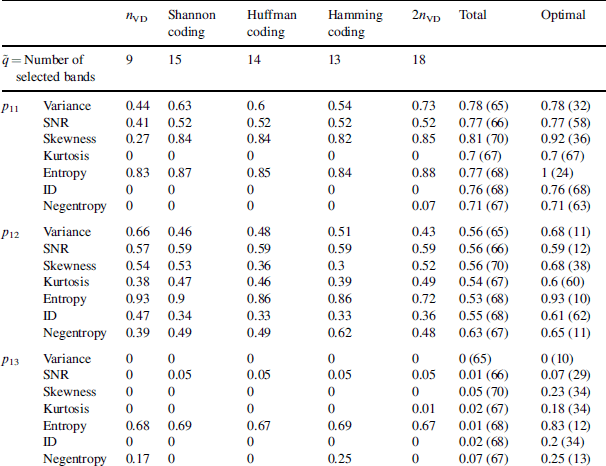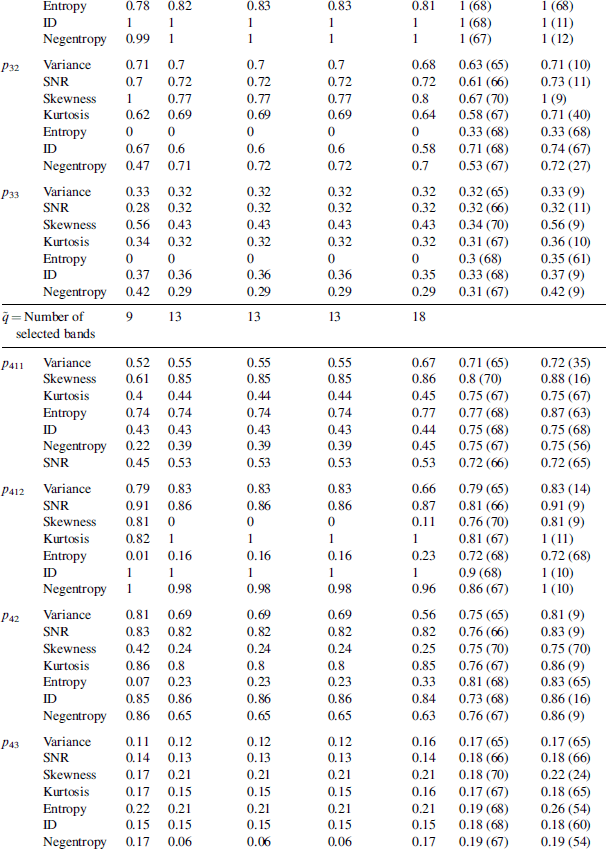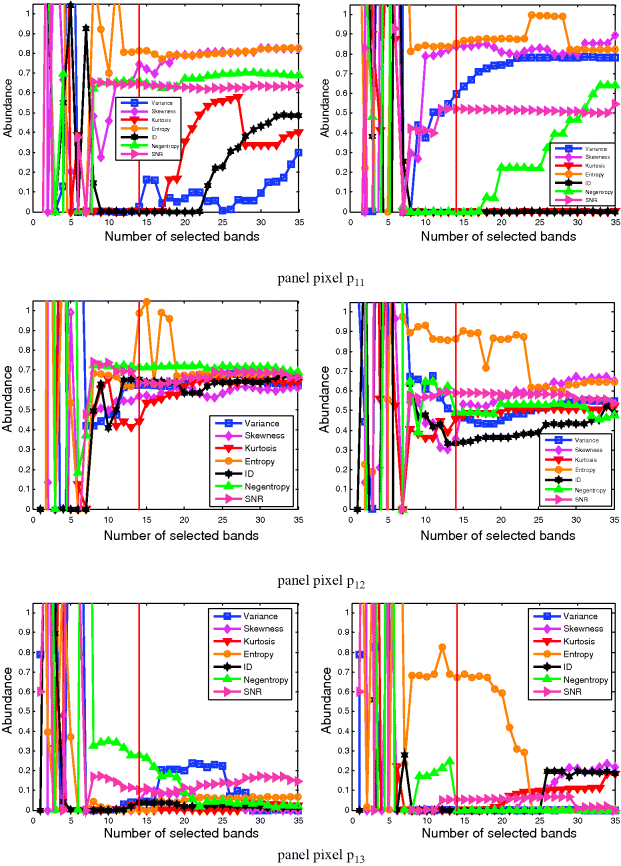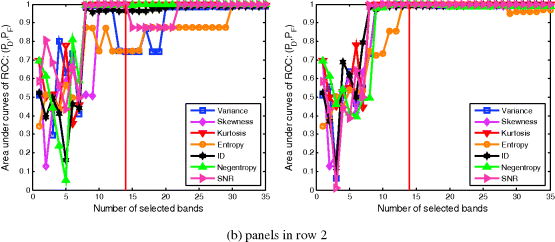23.7 Linear Spectral Mixture Analysis
The HYDICE 15-panel scene in Figure 1.15 was used for experiments where the 19 R panel pixels, p11, p12, p13, p211, p221, p22, p23, p311, p312, p32, p33, p411, p412, p42, p43, p511, p521, p52, and p53, provided by the ground truth in Figure 1.15(b) were used for quantitative analysis. According to the ground truth in Figures 1.15, 1.16, 1.17, nine signatures, m1 = p1, m2 = p2, m3 = p3, m4 = p4, and m5 = p5 in Figure 1.16 and background signatures, m6 = grass, m7 = road, m8 = tree, and m9 = interferer in Figure 1.17, were used to unmix these 19 R panel pixels for panel detection and quantification.
Table 23.4 gives the first 35 highest prioritized “de-correlated bands” by ID-BD with the threshold value ε set to 0.1 and the corresponding “BD-removed bands” where seven BP criteria, variance, SNR, skewness, kurtosis, entropy, ID, and negentropy, are used to prioritize bands.
Table 23.4 First 35 highest prioritized BP/BD bands and corresponding removed bands after ID-BD with ε = 0.1 using 7 BP criteria for BP of HYDICE data.
| BR/BD bands | Corresponding removed bands | |
| Variance | 60/56/78/53/52/55/54/49/45/92/38/34/28/26/ 27/25/24/23/22/20/21/102/19/18/17/16/15/ 14/13/12/11/10/84/9/8 |
61/67/66/65/59/57/68/62/64/77/76/79/63/80/ 58/75/81/69/50/82/48/51/46/70/47/44/43/ 42/41/74/93/91/40/95/39/90/94/37/96/89/ 83/36/35/33/88/32/71/31/30/97/29/87/73/ 103/108/105/104/109/101/106/107/111/ 110/112/113/100/114/72/115/99/86/116 |
| Skewness | 1/122/50/127/2/169/168/128/129/45/167/22/ 23/21/18/20/24/19/17/16/15/10/3/8/25/14/ 13/5/11/12/132/9/7/4/133 |
123/124/125/126/49/48/47/51/46/130/166/44/ 131/43/165/42/164/41 |
| Kurtosis | 1/59/69/74/83/56/85/86/93/55/54/122/109/2/ 120/3/127/130/128/132/4/133/134/144/145/ 143/135/141/140/146/138/139/136/53/137 |
60/61/62/64/63/65/66/58/67/68/57/70/80/82/ 81/72/79/78/77/76/75/71/84/73/92/95/91/ 94/90/88/89/87/96/97/108/113/112/110/ 111/123/114/107/106/115/105/116/104/ 117/103/118/121/119/124/102/101/126/ 131/100/129/125/99/98/142/152/153/154/ 147/151 |
| Entropy | 46/24/124/21/40/18/26/23/22/25/16/17/27/20/ 19/165/15/167/9/168/12/36/169/98/35/14/ 29/28/53/6/10/13/156/7/2 |
47/49/48/51/45/44/43/50/41/42/52/125/39/38/ 123/126/122/37/129/166/164/163/162/130/ 160/161/159/131/32/99/33/30/31/158/34/ 157/100/142/154/155 |
| ID | 59/81/56/85/94/86/71/84/55/4/145/120/109/ 135/146/139/138/133/141/136/143/132/ 137/134/140/54/150/128/8/1/127/11/3/2/13 |
60/63/62/61/65/58/57/64/66/80/79/67/82/70/ 83/74/68/72/77/76/69/78/91/92/93/75/88/ 95/90/89/96/87/73/97/113/115/112/114/ 111/116/110/118/108/106/117/107/105/ 104/119/121/103/144/151/148/102/149/ 152/147/155/142/101/154/153/100/157 |
| ICA | 1/81/93/85/68/84/86/56/55/111/54/120/53/33/ 149/146/145/28/143/37/141/139/140/137/ 138/27/52/136/26/135/25/44/24/19/14 |
82/80/79/78/92/95/77/94/91/76/96/90/75/89/ 88/83/74/67/70/66/87/69/65/64/61/60/59/ 62/63/72/57/97/58/73/71/112/110/113/114/ 109/115/108/116/107/106/117/105/118/ 104/119/121/103/102/34/32/101/31/150/ 148/30/36/147/151/29/35/152/100/153/142/ 144/154/155/38/39/156/99/40/157/158/159/ 41/42/160/43/161/162/45 |
| SNR | 78/93/102/62/56/49/44/53/55/52/54/38/120/ 137/138/136/139/134/140/133/141/85/135/ 132/86/143/131/128/145/32/84/144/146/ 122/28 |
80/91/92/95/89/94/90/88/96/79/82/105/107/ 108/104/109/101/110/103/63/106/77/61/ 111/70/112/100/114/113/75/99/59/116/57/ 83/60/117/118/46/47/66/69/64/45/115/50/ 119/97/51/67/87/43/42/58/71/41/72/98/39/ 37/65/73/142/31/33/147/130/129/30/29 |
Using the nine signatures, m1 = p1, m2 = p2, m3 = p3, m4 = p4, and m5 = p5, m6 = grass m7 = road m8 = tree, and m9 = interferer, with the signature mean chosen to be the reference signature, DDA was calculated by Shannon coding, Huffman coding, and Hamming coding with SAM and SID used to measure spectral similarity and their results are given in Table 22.5. Table 23.5 gives FCLS-unmixed abundance fractions of 19 R panel pixels using prioritized bands with/without ID-BD via PBS with various values of ![]() determined by VD, DDA, and optimal FCLS performance. Also, note that the column “total” in Table 23.5 was not 169 because some bands are already removed by BD. In this case, the numbers in parentheses were actual total numbers after BD.
determined by VD, DDA, and optimal FCLS performance. Also, note that the column “total” in Table 23.5 was not 169 because some bands are already removed by BD. In this case, the numbers in parentheses were actual total numbers after BD.
Table 23.5 FCLS-unmixed abundance fractions of the 19 panel pixels in the HYDICE data using various values of ![]() determined by VD, DDA, and optimal FCLS performanc.
determined by VD, DDA, and optimal FCLS performanc.




From Table 23.5, the best estimate for ![]() seems to be 9, 10, and 11.
seems to be 9, 10, and 11.
Figure 23.3 shows FCLS-unmixed abundance fractions of the 19 R panel pixels using PBS with prioritized bands in Table 23.4 where the figures on the right and the left were obtained by PBS with/without using ID-BD, respectively.
Figure 23.3 FCLS-unmixed results of the 19 R pixels using PBS prioritized bands with figures on the right and on the left obtained by PBS with/without ID-BD and DDA = 14 (Huffman coding).






As shown in Figure 23.3, the performance of unmixing the 19 R pixels was significantly improved when ID-BD was implemented prior to FCLS. This implies that the ID-based BD effectively removed redundancy bands so as to increase FCLS performance. An interesting observation is worthwhile where some panel pixels using only a few bands performed better than those using more bands.
Finally, the ground truth of the 19 R panel pixels provided in Figure 1.15(b) was further used to calculate averaged detection rates of the panel pixels in each row according to ROC analysis in Chapter 3. Figure 23.4(a)–(e) hows the areas under their 2D ROC curves of (PD,PF) resulting from using PBS with prioritized bands with/without ID-BD where figures on the right and on the left are obtained by PBS with/without ID-BD and DDA = 14 (Huffman coding) and vertical lines were also used to show the cutoff threshold determined by DDA = 14 calculated by the Huffman coding. Figure 23.4(f) shows the overall averaged panel pixel detection rates specified by the areas under 2D ROC curves of (PD,PF) obtained by averaging the areas under 2D ROC curves of (PD,PF) in Figure 23.4(a)–(e).
Figure 23.4 Areas under 2D ROC curves of (PD,PF) with figures on the right and on the left obtained by PBS with/without ID-BD and DDA = 14 (Huffman coding).






As we can see from Figure 23.4(f), the value 14 of DDA determined by the Huffman coding indeed provided a very good estimate for the value of ![]() .
.
